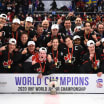PITTSBURGH -- Standing onstage at Microsoft Theater in Los Angeles last month, a proud Mario Lemieux was surrounded by fellow members of the 100 Greatest NHL Players presented by Molson Canadian and talking about how one of them, Sidney Crosby, had changed the fortunes of the Pittsburgh Penguins.
"He saved our franchise again," Lemieux said, repeating a phrase he's uttered frequently during the 12 seasons since that fateful day when the Penguins won the 2005 NHL Draft Lottery and the right to select Crosby at No. 1.
Sidney Crosby's legacy in Pittsburgh goes beyond Cup
Two-time champion has 'saved' Penguins, sparked surge in area youth hockey
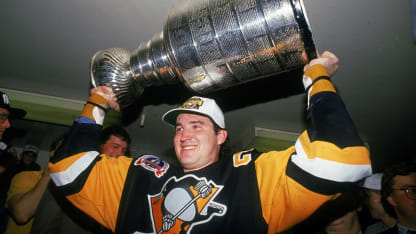
© B Bennett/Getty Images
As a player, Lemieux had done something similar for the Penguins after they selected him at No. 1 in the 1984 NHL Draft. As co-owner of the Penguins, Lemieux has seen history repeat itself and more with Crosby, who has not only helped turn around what had been a struggling team and twice captained it to the Stanley Cup, but also reinvigorated and expanded the roots of the sport in the city and surrounding region.
Some of the breadth of Crosby's impact will be on display this weekend during a celebration of Pittsburgh and Pennsylvania hockey that centers around the 2017 Coors Light Stadium Series, with the Penguins facing the Philadelphia Flyers at Heinz Field on Saturday (8 p.m. ET; NBC, SN, TVA Sports 2, NHL.TV).
It began Thursday with
Crosby and some teammates joining a group of randomly selected youth players
from Sidney Crosby's Little Penguins Learn to Play program for a practice at UPMC Lemieux Sports Complex in Cranberry Township. On Sunday afternoon, two teams from the Pittsburgh Penguins Elite AAA youth program will play games against their counterparts from the Flyers Team Virtua at Heinz Field.
The Robert Morris University men's hockey team, a Division I NCAA program housed at the Island Sports Center in Pittsburgh, will play Niagara University at Heinz Field on Sunday night.
It's unlikely any of this could have happened without Crosby, which is why Penguins CEO and president David Morehouse said, "His off-ice legacy is just as impactful as his on-ice legacy, if not more.
"He's had an impact on Pittsburgh in ways that you can't even measure."
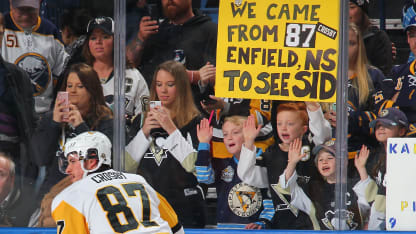
© Bill Wippert/Getty Images
\\*
The Penguins, who are celebrating their 50th anniversary this season, might not have been around for Crosby to save if Lemieux hadn't done it first. In 1983-84, the Penguins went 16-58-6 with 38 points, the lowest total in their history, and ranked last in the NHL with an average attendance of 6,839 per game, according to hockeydb.com.
With Lemieux leading the way, they won the Stanley Cup in 1991 and 1992 and topped 16,000 in average attendance five consecutive seasons from 1992-93 to 1996-97. Participation in the sport also increased.
"Before Mario Lemieux was drafted in Pittsburgh, there were six rinks in the region," Morehouse said. "When he retired [in 2006], there were 33."
Lemieux retired for the first time at 31 after the 1996-97 season but returned in 2000-01, when the Penguins averaged 16,277 in attendance and he teamed with Jaromir Jagr to lead them to the Eastern Conference Final.
By that point, Lemieux was also majority owner of the Penguins after he turned some of the money he was owed in deferred salary by previous ownership, which declared bankruptcy in 1998, into a controlling stake in the team. Lemieux stepped in to save the Penguins, at least temporarily putting off speculation that they would relocate to another city.
But partly because of their financial struggles, Jagr was traded to the Washington Capitals following the 2000-01 season, and the Penguins missed the Stanley Cup Playoffs the following four seasons. In 2003-04, the Penguins went 23-47-8 and finished last in the NHL with 58 points. They also were last in the League in average attendance at 11,877.
With the Penguins in desperate need of a new building to replace outdated Mellon Arena, they were again dogged by talk of relocation.
"We all thought we were going to Kansas City," said Capitals defenseman Brooks Orpik, who played for the Penguins from 2002-03 to 2013-14. "That kind of seemed like it was a foregone conclusion. I guess being older now and looking back at the situation, I don't know how close it really was."

© B Bennett/Getty Images
\\*
In June 2005, William "Boots" Del Biaggio, a Silicon Valley financier, negotiated a letter of intent with Lemieux to buy the Penguins with the intention of helping them get a new arena in Pittsburgh. That deal eventually fell through, but not until after July 22, 2005, the day of the NHL Draft Lottery.
Crosby was the unquestioned prize of that year's draft, and Pittsburgh fans who are old enough know exactly where they were when they heard the Penguins won the lottery.
"I remember I was sitting in my living room," said Jacob Coleman, a freshman forward at Robert Morris and native of Moon, Pennsylvania. "I remember that day like it was yesterday."
Goaltender Marc-Andre Fleury, the lone remaining Penguins player from before Crosby's arrival, doesn't remember where he was on the day of the draft lottery, but knows well what it meant to the organization.
"Before [Crosby] got here, we weren't winning much. Every game was tough," Fleury said. "Then Sid came along, [Evgeni Malkin] came along, [Jordan Staal] came along and together with a few guys in the minors some young guys came in. Sid has been the face of this team and of the League since then."
Although the Penguins again finished last in the NHL with 58 points (22-26-14) in Crosby's rookie season of 2005-06, their average attendance jumped to 15,804 (20th in the League). Still struggling to secure a deal for a new arena, Lemieux, who retired as a player for good in January 2006, nearly sold the Penguins to Canadian businessman Jim Balsillie later that year before the sale was called off in mid-December because Balsillie wouldn't guarantee he'd keep them in Pittsburgh.
Three months later, the Penguins reached an agreement with city, county and state officials on financing for a new arena and announced on March 13, 2007, that they were staying in Pittsburgh. They reached the Stanley Cup Final in 2008, and a year later Crosby, 21 at the time, became the youngest captain in NHL history to lift the Stanley Cup.
The Penguins moved into Consol Energy Center (renamed PPG Paints Arena in October) to begin the 2010-11 season. This season, they are averaging 18,552 in attendance (11th in the NHL) and have extended their run of consecutive sellouts to 462 since Feb. 14, 2007.
Morehouse, who joined the Penguins in 2005 as a consultant and was named president in 2007, credited the persistence of Lemieux and co-owner Ron Burkle in making the new arena deal but said public support put it over the top "largely because of Sidney Crosby."
"We were in last place, we were last in revenues, we were last in attendance, our TV ratings were minimal and we were in the oldest building in the NHL," Morehouse said. "We were able to draw attention to us as a franchise because of the drafting of Sidney Crosby and the subsequent success we had."
\\*
Crosby's contributions to the Penguins on the ice alone probably would have been enough to spark at least a small surge in participation in youth hockey in the Pittsburgh area if he or the Penguins hadn't lifted a finger to help. That's essentially what happened during Lemieux's playing career and Jagr's time with the Penguins.
"When I got here, I remember looking at our books and seeing that we were making money off of youth hockey, but we weren't investing money into youth hockey," Morehouse said. "So we immediately reversed that, and with Sid's help."
Crosby approached the Penguins with the idea of starting a youth hockey program, and
Sidney Crosby's Little Penguins
were born in 2008. Crosby brought in Reebok Hockey (now CCM), and the Penguins got Dick's Sporting Goods involved. Together each year they arranged for 1,000 boys and girls ages 5-7 to receive a complete set of equipment for free and set them up in Learn to Play practice sessions at 25 locations throughout the region.
This season, they increased the number of participating players to 1,200 and hope to have it up to 2,000 players next season by splitting the program into two.
"I love the game and if there's an opportunity to help kids enjoy the game and get something out of it and kind of help them have that opportunity, then that's something I wanted to be a part of," Crosby said. "So I was lucky the team wanted to get involved and various sponsors and things like that to make it happen. It's grown a lot and it's nice to see."
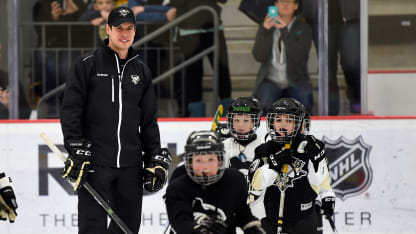
With Crosby's help, youth hockey has taken off in the area. Rich Hixon, who oversees the Learn to Play program and runs the UPMC Lemieux Sports Complex, said that since Crosby was drafted there has been a 152 percent increase in participation in players age 8 and under, the number of female players has doubled and overall youth participation is up 60 percent.
In addition to launching the Little Penguins, the Penguins built 12 deck hockey rinks in the region and donated ball hockey equipment to 600 elementary schools in 10 surrounding counties.
"We gave them all free hockey equipment, plastic sticks and balls, for use in gym class along with a lesson plan that shows them the physical fitness benefits of playing hockey and this is how you teach people to play hockey," Morehouse said.
This is all part of what Morehouse calls the Penguins' "hockey pyramid," which is designed to establish a foundation to grow interest and participation in the sport. It appears to be working.
USA Hockey's annual reports show that participation in Western Pennsylvania dropped from 9,920 registered players in 2001-02, the season after Jagr was traded, to 8,697 in 2004-05, the season before Crosby's arrival.
The number grew to 13,689 by 2015-16, an increase of 57 percent.
\\*
Even without financial backing from the Penguins, the Lemieux and Jagr era inspired a generation of players from the Pittsburgh area, including four who were selected in the 2011 NHL Draft: Columbus Blue Jackets left wing Brandon Saad (by the Chicago Blackhawks in the second round, No. 43), New York Rangers right wing J.T. Miller (first round, No. 15), Anaheim Ducks goaltender John Gibson (second round, No. 39) and Florida Panthers center Vincent Trocheck (third round, No. 64).
"When I was really young, when I first started playing and I was going to games, I watched Mario," Gibson said. "But I just really liked going to games. When I was older, Sid was there and those guys were playing, so it was cool watching them."
Gibson, Saad, Miller and Trocheck came up through the Pittsburgh Hornets AAA program, which also produced Dallas Stars defenseman Stephen Johns and Ducks defenseman Nate Guenin, before continuing their hockey development elsewhere. Trocheck's family moved to Detroit so he could play for the Little Caesars program there.
The Penguins want to give youth players the opportunity to stay in the Pittsburgh area throughout their development. That's why they took over the Hornets in 2012 and formed the Pittsburgh Penguins Elite AAA program for boys and girls.
They now have 22 AAA teams -- 15 boys teams (10 and under to 18 and under) and seven girls teams (10 and under to 19 and under) -- playing out of UPMC Lemieux Sports Complex. The 18-and-under boys team won the USA Hockey National Championship last season.
Although the primary function of UPMC Lemieux Sports Complex, which opened prior to the 2015-16 season, is to serve as the Penguins' practice home, players in the Elite program have access to all of the facilities. They work in the strength and conditioning program headed by former Penguin Gary Roberts and go onto the ice with Penguins skills development coach Ty Hennes and power skating coach Max Ivanov.
"So from standpoint they get the same training on and off the ice as our NHL guys do, obviously age-appropriate," Hixon said.
Since 2012, the Penguins Elite program has had more than 60 players (men and women) go on to play junior hockey, in the North American Hockey League and the United States Hockey League, or at the college level.
Hixon said the Penguins Elite 16-and-under girls team has eight players with commitments to play college hockey beginning in two years and that two players from the 19-and-under girls team also have college commitments. Ultimately, the program would like to produce another wave of NHL players from Pittsburgh.
"I think you're going to see that with the growth of the other athletes," Hixon said. "I think our best players are 2002 or 2001 birth year on down. But even last year we had a number of kids come out and have an opportunity to go on an advance their careers in the USHL and in college."
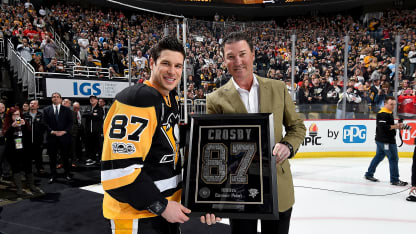
© Joe Sargent/Getty Images
\\*
Morehouse views UPMC Lemieux Sports Complex, which has two sheets of ice as well as off-ice training and sports medicine facilities, as a culmination of the efforts the Penguins have made to grow hockey in the area and "a platform" to show it off.
Its main rink was packed with a sellout crowd of more than 1,000 for the National Women's Hockey League All-Star Game on Feb. 12, though Pittsburgh does not have a team in the league. On March 21 and 22, it will host the Penguins Cup finals from the AAA, AA, and A classifications of the Pennsylvania Interscholastic Hockey League (Western Pennsylvania high schools) for the second straight season.
The Penguins Cup finals were previously held at PPG Paints Arena and Mellon Arena. PIHL commissioner Craig Barnett, the former varsity coach at Cathedral Prep in Erie, said some were skeptical of the shift to the smaller venue last season, but it worked out well.
"We had a standing-room-only crowd and when you put 1,000 people in that arena that atmosphere was unbelievable," said Barnett, an Oakville, Ontario, native and former goaltender who briefly played professionally in the ECHL and International Hockey League. "You could close your eyes and it would feel like you were in the old Montreal Forum. So after being part of that last year, I like that approach. I like the environment, the atmosphere and our kids loved it."
The PIHL includes more than 150 teams from more than 60 schools at the varsity, junior varsity and middle school level. The jerseys from the varsity high school programs are displayed on the PPG Paints Arena concourse, along with those from local amateur teams.
Barnett said Crosby's presence also has had an impact at the high school level.
"Certainly Sidney Crosby coming to town kind of rejuvenated the whole area with the success the Penguins have had," he said. "From a high school perspective, I think we're really seeing that boom now. I look at our youth hockey leagues and I see the mites and squirts are busting at the seams in the Pittsburgh area because of that [2016] Cup. I would say that in terms of numbers, high school hockey will benefit from that in probably six, seven years down the road."
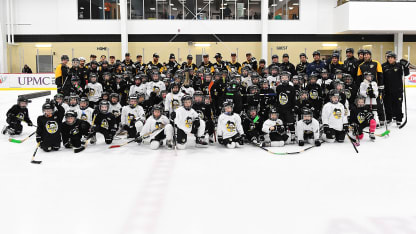
© Joe Sargent/Getty Images
\\*
Hockey is also thriving at the Division I college level with the men's and women's varsity teams at Robert Morris. The Colonials women's team is 20-4-6 and ranked No. 9 in the nation in the latest USCHO.com Poll. The men's team is 17-11-4 with two games remaining before the Atlantic Hockey Association postseason tournament.
The Colonials men's team, which began play in 2004-05, earned its first NCAA Tournament bid in 2013-14 by winning the AHA tournament. The Colonials also won conference regular-season titles in 2014-15 and 2015-16.
This season, they won the Three Rivers Classic tournament, played at PPG Paints Arena, for the third time in five seasons with a 5-2 victory in the final against Quinnipiac, which lost in the NCAA Frozen Four title game last season.
Coach Derek Schooley, who has been with the men's program from the start, said he's had at least two players from the Pittsburgh area on the team each season. This season, he has three: freshman forward Jacob Coleman, freshman forward Luke Lynch and sophomore forward Alex Dagnal.
During his 13 seasons, Schooley said, he has witnessed up close an improvement in the quality and number of players coming out of the Pittsburgh area.
"You see the increase in youth hockey development and youth hockey participation because of the success of the Penguins and because of Sidney Crosby, because of Malkin, because of Fleury," Schooley said. "You see [Pittsburgh area] players growing up to want to be those guys. You see that happen and then sometimes around the rink you see some of youth hockey players wearing our players' jerseys."
The Colonials men's team has had 59 players go on to play professionally. Some have attended NHL development camps and training camps, but none has played in the NHL.
"The next progression is to finally get a Colonial in the NHL," he said, "and we'll be excited when that happens, that's for sure."
The Colonials' relationship with the Penguins helps. They play some games every season at PPG Paints Arena and they'll get to play at Heinz Field on Sunday.
"It's going to be pretty crazy," Lynch said. "I'll have a good amount of family there. Playing there is an unbelievable opportunity and we're all super excited for it."
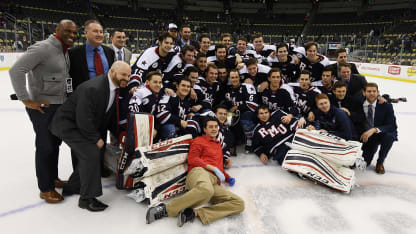
© Justin Berl/Getty Images
\\*
Any conversation about Pittsburgh hockey will at some point include a reminder that this is a football town first, with its blue-collar mentality forged in the old steel mills. So it is appropriate that the Penguins will play at the home of the NFL's Pittsburgh Steelers on Saturday, as they did in the 2011 Bridgestone NHL Winter Classic against the Washington Capitals.
Though football remains No. 1 in Pittsburgh, hockey has made inroads during the past dozen years with growth in participation and development of players and by cultivating fans. City officials estimated that between 380,000 and 400,000 people lined the streets for the Penguins' Stanley Cup parade last June, making it the largest crowd for a sports celebration in Pittsburgh history.
"It's always been a football city and the baseball team had success and they're doing better now," Gibson said. "But I think the more people you talk to, hockey is pretty close with football there now."
Morehouse, who is from the Beechview section of Pittsburgh, remembers some youth players who picked up the game during what he calls "the Mario Lemieux generation" being coached by football coaches who wore cleats on the ice because "we didn't have enough former players to coach them."
That's no longer the case.
"Pittsburgh's become more of a hockey town," Schooley said. "You see it with the success the Penguins have had and the support they've gotten. They had 20,000 people outside watching one of the Stanley Cup Final games, and you just see the support of hockey from the Penguins down to [Robert Morris] down to high school down to youth hockey just increasing year after year."
Crosby, 29, has played a role, directly or indirectly, in all of it. That, as much as his Stanley Cup rings and individual on-ice accomplishments, will be part of his legacy in Pittsburgh.
Crosby said that is his hope with the Little Penguins.
"I think that when you're in positions to be able to help and give back, that's something that when you get to the NHL you have a great opportunity to be able to do that," he said. "I'm definitely happy that it's continued and it's continued to grow."
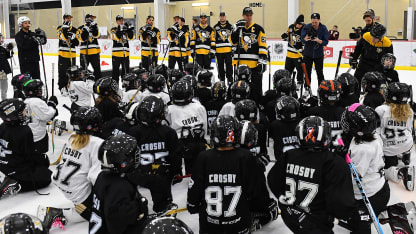
© Joe Sargent/Getty Images












